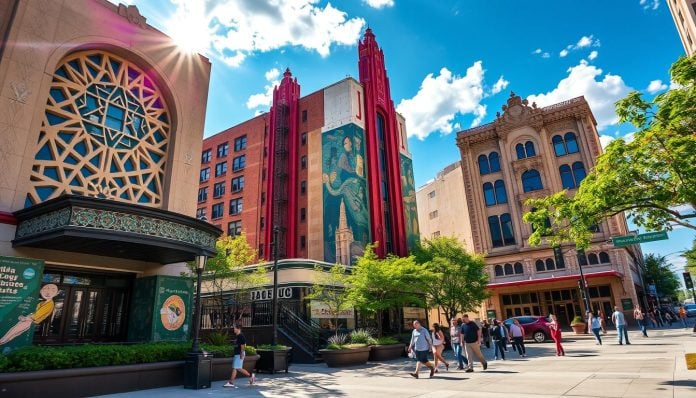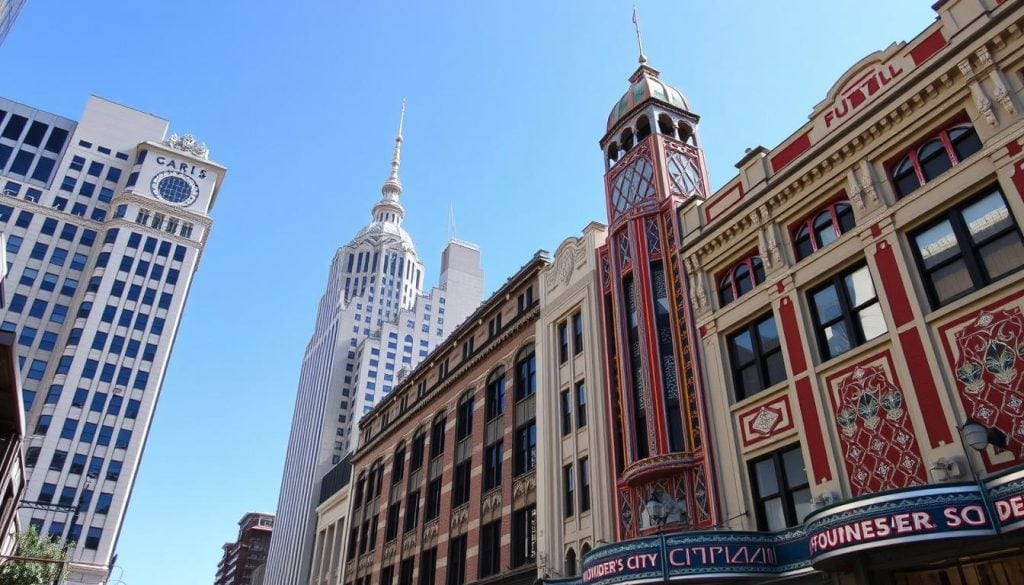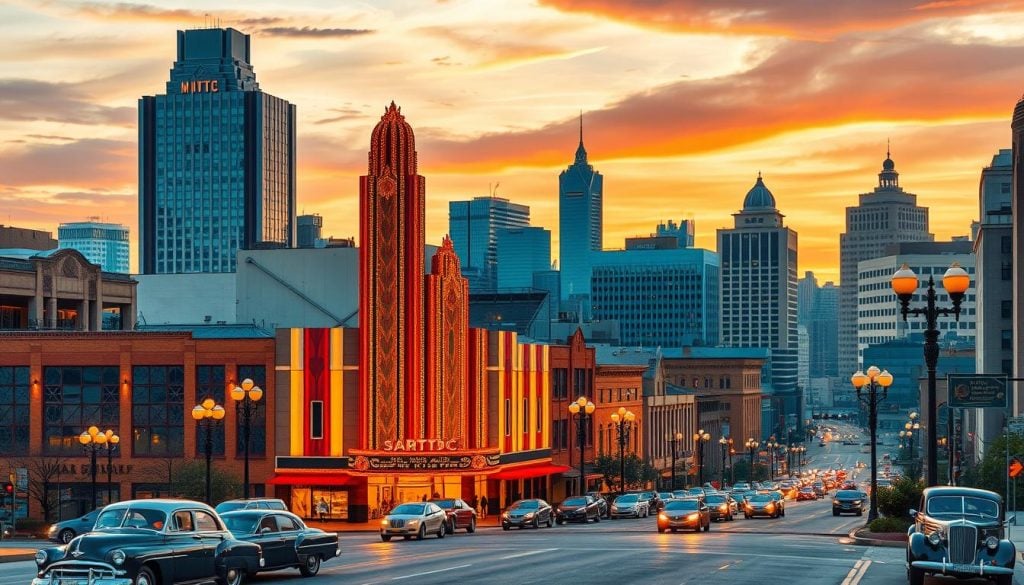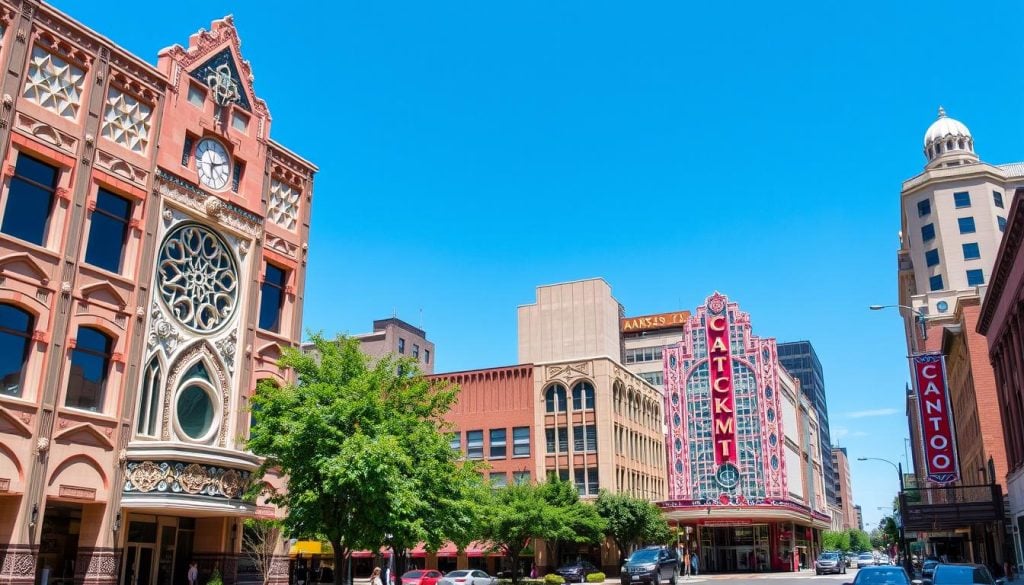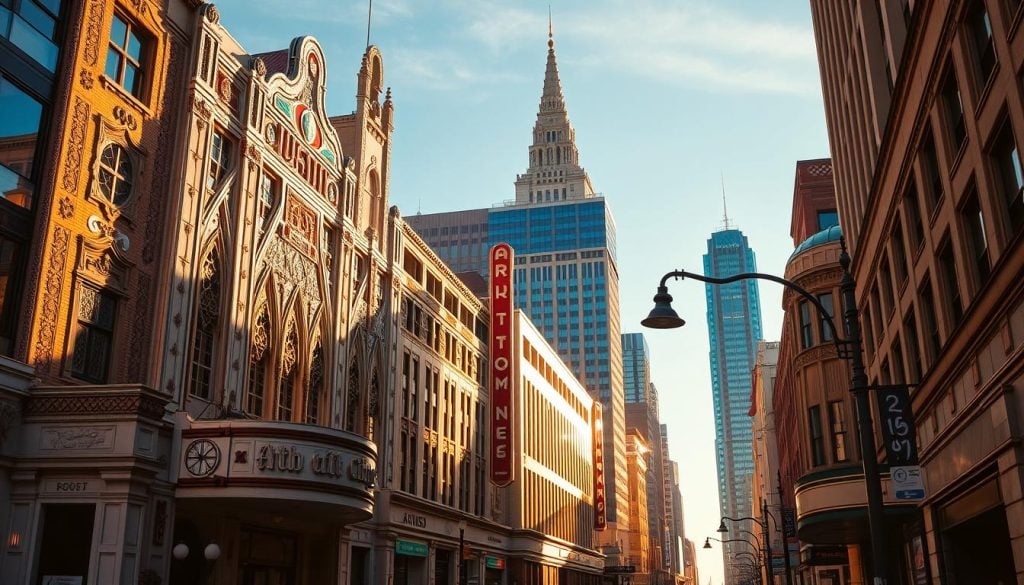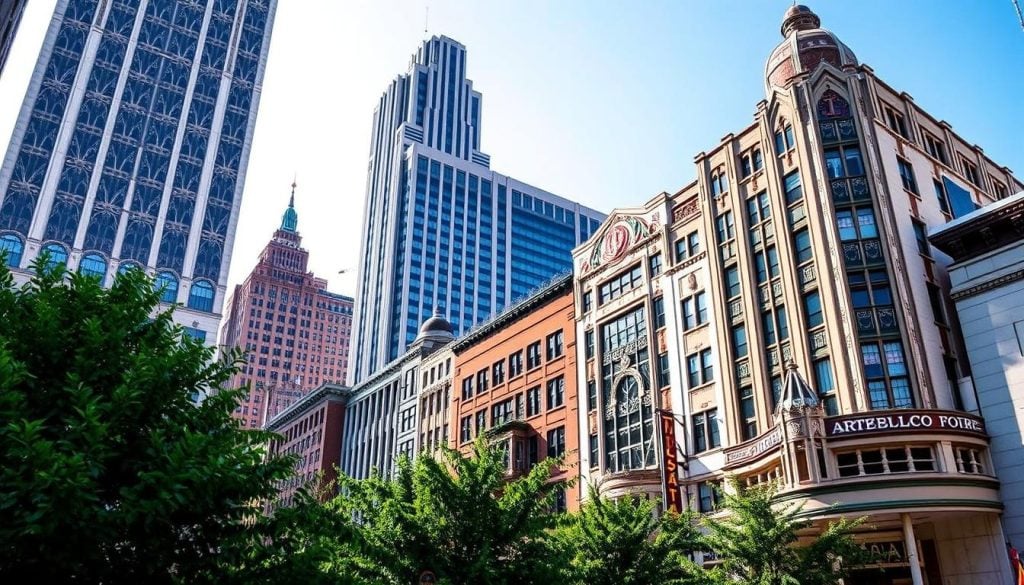Imagine the buildings around you sharing stories of a city’s growth through art and design. On an Art Deco architecture walking tour in Kansas City, you can dive into the rich history of this style. It’s where elegance meets modernity. As you walk through downtown, each landmark tells a story of the past.
It shows Kansas City’s dream to change itself in the early 1900s. This guide will help you find important spots and give you stories that make your tour better. You’ll see grand buildings and small details that show the city’s artistic side.
The Allure of Art Deco Architecture in Kansas City
Art Deco architecture is known for its bold shapes, bright colors, and rich materials. In Kansas City, it shows the city’s growth and modern look in the early 1900s. Buildings with chrome, terracotta, and detailed metalwork tell stories of hope during tough economic times.
The Art Deco buildings in Kansas City have unique designs that share stories of the city’s history. Each building adds to the special charm of this style. Walking through the streets, you see buildings that look forward with a sense of innovation.
Some key features that make Art Deco architecture stand out include:
- Exquisite Details: Buildings are decorated with detailed motifs and designs, making them visually appealing.
- Innovative Materials: Chrome, glass, and terracotta make these buildings symbols of luxury and progress.
- Geometric Shapes: Strong lines and bold shapes give a feeling of energy and movement.
Exploring Kansas City, you’ll see how its Art Deco architecture tells the story of its history and dreams for the future. Each building is a reminder of a time when creativity and design thrived. This created a lively cityscape that still amazes people today.
Understanding the Origins of Art Deco
Art Deco started in the early 1900s, marking a new chapter in art. It came to life at the 1925 International Exhibition in Paris. This event showed off new designs that were both useful and beautiful. It captured the era’s hopes and dreams.
The Influence of the 1925 International Exhibition
The 1925 International Exhibition was key to Art Deco’s development. It featured art, architecture, and products that showed off the era’s spirit. Designers aimed to include elements of progress, catching everyone’s eye. Their work mixed geometric shapes and luxury materials, showing a world where new and lavish could meet.
How Art Deco Reflects Modernity and Extravagance
Art Deco is all about modernity and luxury. It’s known for its clean lines, bright colors, and new materials like chrome and glass. These elements celebrated technology and attracted those seeking elegance. Art Deco pieces today still make us feel rich and show off the creativity of that time.
| Aspect | Details |
|---|---|
| Time Period | Early 20th Century |
| Key Event | 1925 International Exhibition |
| Design Elements | Geometric Shapes, Bold Colors |
| Materials Used | Chrome, Glass, Concrete |
| Themes | Modernity, Extravagance |
Art Deco architecture walking tour in Kansas City
Starting an Art Deco architecture walking tour in Kansas City is a unique way to see the city’s history and beauty. You’ll visit key landmarks that show how Kansas City changed in the 1920s and 1930s. You can go on a guided tour or explore on your own.
Key Stops Along the Tour
- Municipal Auditorium: A masterpiece of modern design, this venue exemplifies the Art Deco style’s elegance.
- Kansas City Power and Light Building: This iconic skyscraper showcases the innovative spirit of the era.
- Liberty Memorial: A tribute to history, this landmark seamlessly blends historical significance with Art Deco motifs.
Exploring the Historical Context of Each Landmark
Every stop on the Art Deco architecture walking tour in Kansas City tells a part of the city’s story. Learning about the history of these buildings helps you appreciate their design and what they mean:
- The Municipal Auditorium was the place for many big events, showing the city’s lively culture.
- The Kansas City Power and Light Building symbolizes the city’s growth in industry and modernity during that time.
- Liberty Memorial honors those who sacrificed during war, with its beauty and the dedication of its creators.
Iconic Landmarks of Kansas City’s Art Deco
Exploring Kansas City’s Art Deco takes you to stunning buildings that show the city’s rich history and culture. The Municipal Auditorium and the Kansas City Power and Light Building are key examples. They highlight the city’s love for modern design during the Art Deco era.
Municipal Auditorium: A Modern Statement
The Municipal Auditorium opened in 1935 and marks a big moment in Kansas City’s Art Deco story. Its simple look hides detailed ornaments that reflect the era’s architectural dreams. It also shows how the city rebuilt and looked forward to a bright future.
Kansas City Power and Light Building: The Skyscraper of the Era
Built in 1931, the Kansas City Power and Light Building stands tall with its unique sunburst designs. A special lantern on top makes it even more striking. Along with the Municipal Auditorium, these buildings show the amazing architecture of Kansas City’s past.
Highlighting Kansas City’s Historic Buildings
Kansas City is full of historic buildings that show the city’s growth. The Jackson County Courthouse, City Hall, and Fidelity National Bank & Trust Company Building are key examples. They mix different styles to make the city’s look unique.
Jackson County Courthouse: A Blend of Art Deco and Neoclassical Style
The Jackson County Courthouse was finished in 1934. It combines Art Deco and Neoclassical styles beautifully. Its design is grand, with detailed work and a strong look. It’s a key piece of the city’s history.
The building’s stone work and sculptures show the skill of the time. It’s a must-see for those who love architecture.
City Hall: A Reflection of Transportation Advancement
City Hall shows how transportation changed the city’s buildings. It has sculptures that celebrate different transport types. This shows the innovation of its time.
As a historic landmark, City Hall reminds us of how transportation helped shape the city. It’s a key part of Kansas City’s story.
Fidelity National Bank & Trust Company Building: Gothic Revival Meets Art Deco
The Fidelity National Bank & Trust Company Building is another gem in Kansas City’s architecture. It mixes Gothic Revival and Art Deco styles for a special look. The twin spires stand out, making it a key part of the city’s skyline.
The Role of Local History in Shaping Art Deco’s Presence
The 1920s in Kansas City were a big change for Art Deco architecture. This change showed off the local history and culture. The city grew fast, bringing in new buildings that still stand today.
A Look at Kansas City’s Economic Transformation in the 1920s
In the 1920s, Kansas City’s economy grew a lot thanks to new industries and more people moving in. This led to a push for modern buildings. Soon, Art Deco buildings became famous for their looks and usefulness.
Community Contributions to the Art Deco Movement
Art Deco in Kansas City got a boost from local artists, architects, and the community. People like Edward Tanner and Hollis & Miller designed important buildings. They added local touches to their work, making people proud of their city’s history.
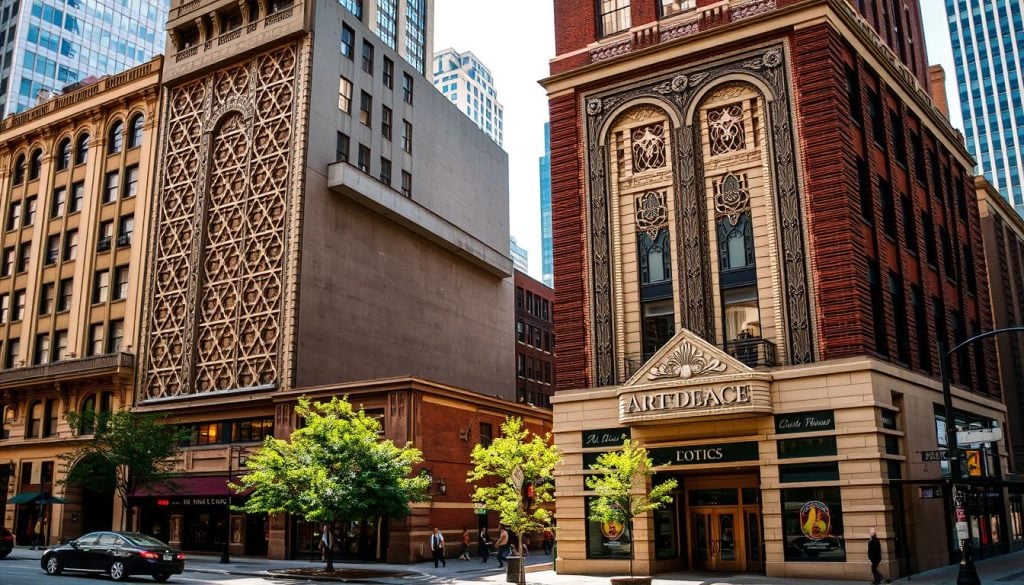
Guided Tours vs. Self-Guided Explorations
Deciding between a guided tour and exploring on your own can change how you see Kansas City’s Art Deco architecture. Each choice has its own benefits, fitting different ways of seeing the city.
Benefits of Taking a Guided Art Deco Tour
A guided tour lets you learn from experts. They tell stories and share insights about the buildings you see. You’ll move from one landmark to another easily, thanks to their plans.
Guided tours often include:
- In-depth historical context provided by expert guides
- Access to exclusive locations or behind-the-scenes areas
- Safety and convenience through organized routes
Creating Your Own Itinerary for Urban Exploration
Self-guided tours let you explore at your own pace. You can focus on what interests you most in Kansas City’s Art Deco. This way, you connect deeply with the architecture you like.
Some benefits are:
- Complete freedom to choose which sites to visit
- The ability to spend more time at certain landmarks
- Opportunity to explore lesser-known locations, enhancing your originality in creating your own itinerary
Both guided tours and self-guided explorations offer great ways to experience Kansas City’s Art Deco. They let you fully enjoy the city’s vibrant architecture.
| Aspect | Guided Tour | Self-Guided Exploration |
|---|---|---|
| Expert Insight | Yes, experienced guides | No, independent research needed |
| Flexibility | Less flexibility, set schedule | High flexibility, adapt as desired |
| Time Management | Organized, less time spent planning | Requires planning, can extend visits |
| Access | Possible exclusive access | Public access only |
Additional Art Deco Gems in Downtown Kansas City
Kansas City is not just about big landmarks. It has many Art Deco gems that show off its rich history. The Union Carbide Building is one example, now condos but still keeping its old charm. This shows how old buildings can be made new again, blending history with today’s life.
Union Carbide Building: A Condominium with Historic Charm
The Union Carbide Building is in the heart of downtown. It mixes history with modern living perfectly. Its design and details bring back the Art Deco style of the 1920s, making it special.
Exploring Lesser-Known Art Deco Structures in Midtown
There are also hidden Art Deco spots like the Southwell Building. These places have unique looks and details that show off the style. Exploring these spots deepens your love for Kansas City’s architecture and connects you to its culture.

































